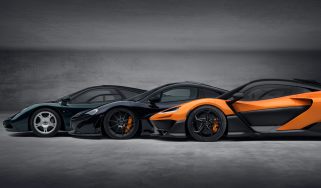The original McLaren F1 press release in full - Every detail of the incredible V12 supercar - McLaren F1 design concept
As McLaren re-publishes the full, original 1992 press release for its F1 supercar, it's a perfect time to celebrate the F1, we think
MASS IS THE ESSENTIAL ENEMY OF DYNAMIC PERFORMANCE IN ANY ‘SUPERCAR’. THERE IS NOSUBSTITUTE FOR LIGHT WEIGHT
The McLaren F1’s design is Formula 1-inspired throughout, yet freed entirely of racing’s regulation strait-jacket. This newfound freedom has unleashed all McLaren Cars’ ingenuity and imagination to perfect numerous frontier-advancing ideas within the F1.
The objective has been simply to build, not only the finest high-performance sports car ever made, but also ever likely to be made.
The McLaren F1 simply redefines such familiar, and often devalued terms as ‘sports car’, ‘Grand Touring car’ and ‘supercar’. It retains the finest virtues associated with each, offering fast and comfortable long-distance touring.
The F1’s forward, centreline driving position and its uncompromisingly ‘driver centric’ cockpit ergonomics reflect pure Grand Prix practise. Their sole objective is to provide maximum visual and dynamic input to ensure instant obedience to driver command.
Its aerodynamic form and features derive directly from Formula 1 technology – light years ahead of any applied by mainstream road car manufacturers.
The full underbody ground-effect aerodynamic management system is further enhanced by fan-assisted removal of ‘boundary layer’ airflow. Further advanced features include active intelligent brake cooling and – crucially – automatic aerodynamic Centre of Pressure control.
Innovative front and rear suspension designs resolve age-old incompatibilities between precision handling and quiet, compliant comfort in a high-performance road car.
The F1 employs conventional Formula 1-style mid-engine mounting – a configuration ideal to combine optimum weight distribution and mass concentration within the wheelbase. Most mid-engined sports car designs compromise such conceptual purity with badly placed luggage, fuel or driver load, or by towering engine/transmission assemblies raising Centre of Gravity height.
Now the McLaren F1 – for the first time in any sports car – avoids all such compromise.
By ingenious packaging it concentrates all its engine/gearbox, fuel, occupant and luggage masses closely around its Centre of Gravity – which is maintained at minimum height and remains static under all load conditions.
The F1’s exceptionally low polar moment of inertia guarantees nimble handling and manoeuvrability. Above all, the McLaren f1 has the highest power-to-weight ratio of any production car yet made.
Mass is the essential enemy of dynamic performance in any ‘supercar’ – there is no substitute for light weight. The F1’s mere 1,018kg (just 2,244lbs) includes the most powerful and efficient purpose-designed large capacity V12 engine ever applied in production. Coupled with a production car chassis designed to be more rigid than any previously conceived – the result is dynamic indeed.
The F1’s incredibly low target weight has been achieved despite meeting exceptionally demanding requirements for strength, stiffness, safety and comfort. Only the most advanced carbon composite structures, the most penetrating design and ingenious conceptual thinking could reconcile these apparently conflicting requirements. The result is the world’s first full advanced-composite production car – a car whose revolutionary features simply re-write the rules.
This is the standard-setting McLaren F1…








